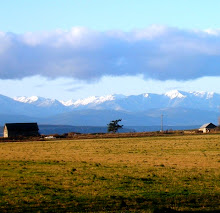The hedgerows at Ebey's Reserve play a similar role in the landscape to the woody British icons. While the hedgerows at Ebey’s Reserve date back only to 1850, the time of early Euro-American settlement, they, too, provide a link to the past of the prairie and the first farms in the area. Hedgerows mark some of the original Donation Land Claim boundaries.

Hedgerows in the Reserve start as unmaintained fencelines, where grasses and shrubs are left to grow up rather than getting mowed. Birds that land on the fences excrete shrub and grass seeds, and more seeds are deposited by wind and water movement, or by small mammals, farm machinery and other vehicles. Before long, the fence becomes hidden among the vegetation, and the hedgerow can grow to be eight feet wide. Over time, a greater diversity of plant species in the hedgerow attracts more wildlife that works to protect the crops.

Hedgerows are beneficial because they…
• Control water runoff by slowing water down as it flows through allowing it to filter into the soil and the aquifer and deposit suspended silt onto the fields, as opposed to it washing into road ditches as it would without a hedgerow.
• Prevent loss of topsoil from wind and water movement. When nutrient-rich topsoil is lost, farmers make up for it by applying fertilizer, which is both expensive, and can overload water bodies with nutrients like nitrogen and phosphorus.
• Buffer wind to maintain soil moisture, leading to increased crop yields. Hedgerows with brushy vegetation and taller trees can increase precipitation over fields by up to fifteen percent.
• Help control pests by providing habitat for insect-eating birds, insects, small mammals and amphibians. Some resident birds feed on weed seeds. If this habitat is destroyed, farmers must instead use poisons, which, like fertilizers, are expensive, and can kill beneficial organisms, and often become ineffective against resistant strains.
• Improve wildlife habitat by providing shade, shelter, food and nesting sites for many mammals and migratory birds. They also provide habitat for bumblebees, which pollinate clover and other cover crops.

Photos by Sierra Young; post adapted from the Ebey's Landing "Hedgerows" brochure



No comments:
Post a Comment